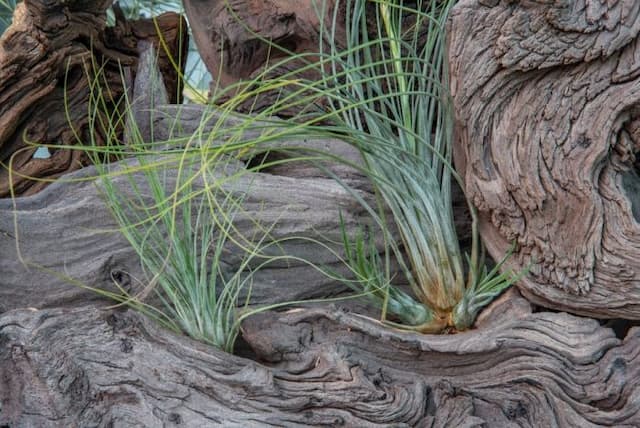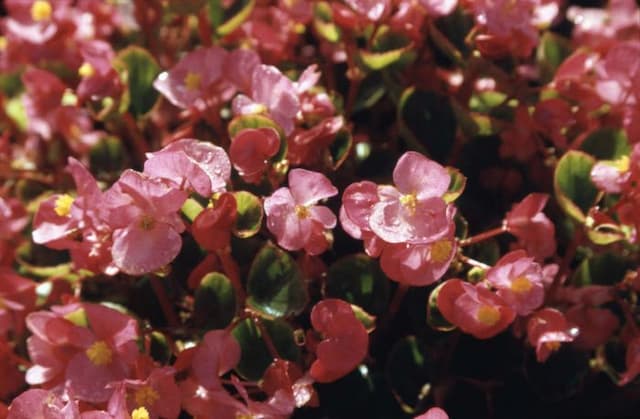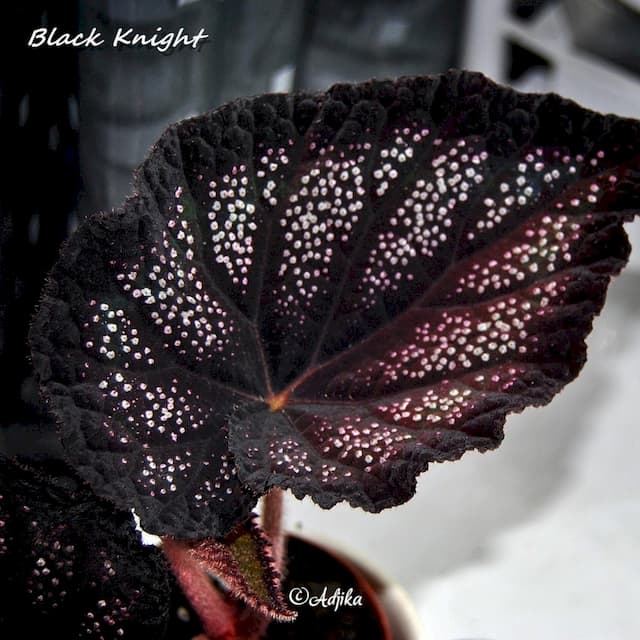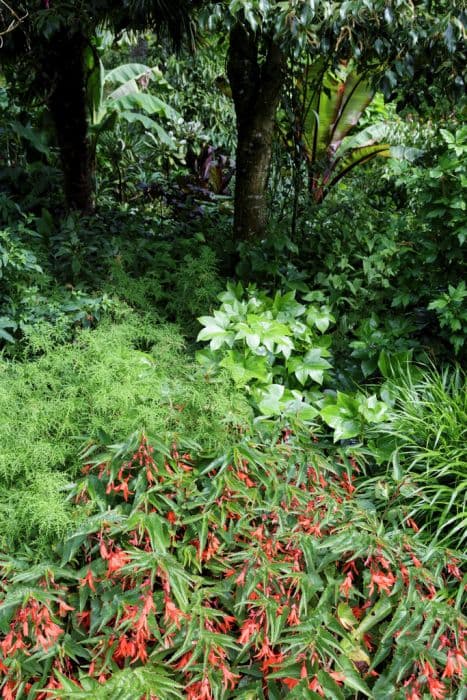Wax Begonia Begonia 'Champagne'

ABOUT
Begonia 'Champagne' presents itself with an elegant display of foliage and flowers. Its leaves exhibit a distinctive palette, characterized by a blend of pale green, which may sometimes transition into a soft, almost silvery hue, creating a shimmering effect that aptly aligns with the 'Champagne' moniker. The leaf surface might display a subtle sheen, while the texture can range from smooth to slightly puckered. The edges of the leaves often have an ornate, serrated pattern, lending a delicate and intricate aesthetic to the overall appearance of the plant. The foliage might feature an asymmetrical growth pattern, with one side of the leaf typically growing more than the other, creating a charming, uneven outline. Blooms on the Begonia 'Champagne' can be found nestled among the leaves, with each flower consisting of dainty petals arranged in a loose cluster. The blossoms are known for their soft colors, sometimes exhibiting shades ranging from white to light pink, which can add a touch of gentle, understated beauty to the plant's appearance. This variety of begonia, like many in its family, could show a bushy, dense growth habit. Stems can appear succulent, supporting the weight of the lush foliage and giving the plant a robust look. While the plant can exude a delicate charm, it simultaneously embodies a sense of vitality and vigor, making it a cherished option for garden enthusiasts and indoor plant collectors alike.
About this plant
 Names
NamesFamily
Begoniaceae
Synonyms
Begonia 'Champagne'
Common names
Begonia 'Champagne'
 Toxicity
ToxicityTo humans
The Begonia 'Champagne', commonly known as begonia, is considered mildly toxic to humans if ingested. It contains oxalate crystals that can cause irritation of the mouth, lips, throat, and gastrointestinal tract. If eaten, symptoms could include a burning sensation in the affected area, swelling of oral tissues, difficulty swallowing, and possible vomiting. Although rarely serious, these effects can be quite uncomfortable and medical attention is advisable if symptoms are severe.
To pets
Begonia 'Champagne', known simply as begonia to most pet owners, is toxic to pets. Similar to its effects in humans, the ingestion of begonias can lead to oral irritation, excessive drooling, vomiting, and difficulty swallowing in pets due to the soluble calcium oxalates within the plant. Particularly for cats and dogs, chewing or ingesting begonia leaves or stems can cause significant discomfort and necessitate a visit to the veterinarian.
 Characteristics
CharacteristicsLife cycle
Perennials
Foliage type
Deciduous
Color of leaves
Varies
Flower color
Varies
Height
1-2 feet (30-60 cm)
Spread
1-2 feet (30-60 cm)
Plant type
Herb
Hardiness zones
10
Native area
Tropical South America
Benefits
 General Benefits
General Benefits- Easy to care for: Begonia 'Champagne' is a low-maintenance plant that requires minimal attention, making it ideal for busy plant owners or beginners.
- Aesthetic appeal: With its beautiful foliage and flowers, this plant adds a decorative touch to any indoor space or garden.
- Adaptability: It can adapt to a variety of indoor lighting conditions, from bright indirect light to lower light environments.
- Seasonal interest: Begonias often bloom throughout the summer, providing a long season of visual interest.
- Compact size: The Begonia 'Champagne' typically remains small, making it a good choice for confined spaces such as apartments and offices.
- Humidity tolerance: This plant enjoys humid conditions, which can be beneficial in certain indoor environments, such as kitchens and bathrooms.
 Medical Properties
Medical PropertiesThis plant is not used for medical purposes.
 Air-purifying Qualities
Air-purifying QualitiesThis plant is not specifically known for air purifying qualities.
 Other Uses
Other Uses- Culinary Garnish: Petals of Begonia can be used to add a colorful and edible touch to salads or as garnishes for cocktails and desserts.
- Biodegradable Confetti: Dried Begonia flowers can be crumbled to make natural, biodegradable confetti for eco-friendly celebrations.
- Artistic Inspiration: Begonia's unique foliage and form can inspire artists and be used as live models for drawing, painting, or photography.
- Natural Dye: The flowers and leaves of some Begonia varieties may be used to extract natural dyes for fabrics or art projects.
- Floristry: Begonia flowers can be incorporated into floral arrangements, adding beautiful texture and color variety to bouquets and centerpieces.
- Educational Tool: Begonia plants can be used to teach botany and horticulture, demonstrating plant growth, propagation, and care.
- Fairy Gardens: With their delicate flowers and interesting leaves, Begonias are perfect for creating enchanting scenes in miniature fairy gardens.
- Holiday Decorations: When in bloom during the holiday season, Begonias can be used to create festive indoor plant displays.
- Texture in Landscaping: Begonia plants, with their varying leaf textures, can add a tactile element to sensory gardens or landscape designs.
- Photography Subject: Due to their photogenic nature, Begonias make an excellent subject for still life photography, highlighting the plant's details.
Interesting Facts
 Feng Shui
Feng ShuiThe Begonia is not used in Feng Shui practice.
 Zodiac Sign Compitability
Zodiac Sign CompitabilityThe Begonia is not used in astrology practice.
 Plant Symbolism
Plant Symbolism- Caution - Begonias can symbolize caution, as they are often seen as a sign to beware or be alert to certain situations.
- Harmony - The balanced and symmetrical shape of the Begonia flowers represents harmony in relationships and a peaceful existence.
- Gratitude - Giving Begonia flowers can express gratitude, appreciation, and acknowledgment for someone's efforts.
- Friendship - The Begonia plant is often associated with friendship and can symbolize deep bonds and an enduring connection with others.
- Individuality - With its unique and varied blooms, the Begonia celebrates individuality and the beauty of being different.
 Water
WaterThe Begonia 'Champagne', commonly known as Champagne Begonia, requires consistent moisture but should not be overwatered. Water the Champagne Begonia when the top inch of soil feels dry to the touch, typically once a week. Use room temperature water and gently pour it around the base of the plant until you see water draining from the bottom of the pot, indicating that the soil is thoroughly moistened. During the active growing season in spring and summer, you may need to water more frequently, possibly every 3-5 days. Reduce watering in the fall and winter when the plant's growth slows down, watering only when the soil is dry several inches down. It's essential to avoid wetting the foliage, as this can lead to fungal diseases. Depending on the pot size and indoor conditions, you might give approximately 8-16 ounces of water per watering session.
 Light
LightChampagne Begonias thrive in bright, indirect light. They should be placed in a well-lit room where they can receive plenty of light without being exposed to direct sunlight, which can scorch their leaves. An east or west-facing window with a sheer curtain is ideal for diffusing light and providing the optimal conditions for growth. If natural light is limited, consider using grow lights to supplement the Champagne Begonia's light needs.
 Temperature
TemperatureThe Champagne Begonia prefers a warm climate and does best in temperatures ranging between 60 to 75 degrees Fahrenheit. Temperatures below 50 degrees Fahrenheit or above 86 degrees Fahrenheit can be harmful to the plant. For optimal growth, maintain a consistent temperature without sudden fluctuations, avoiding drafts, heaters, and air conditioning vents that could cause stress to the Champagne Begonia.
 Pruning
PruningPruning your Champagne Begonia encourages bushier growth and removes any dead or dying leaves to maintain the plant's aesthetic appeal. Snip off spent flowers and yellowing leaves using clean, sharp scissors or pruning shears. The best time to prune is in the spring, just before the growing season begins, but you can lightly prune throughout the year to keep the plant tidy. Pruning every few months should suffice for maintaining the Champagne Begonia's shape and health.
 Cleaning
CleaningAs needed
 Soil
SoilBegonias thrive in well-draining, light soil with a mix of one-part peat, one-part pine bark, and one-part coarse sand or perlite. The ideal pH for Begonia 'Champagne' is mildly acidic to neutral, around 5.5 to 6.5.
 Repotting
RepottingBegonia 'Champagne' should be repotted every 1-2 years or when it becomes root-bound. Repotting is best done in the spring or early summer when the plant is entering its active growing season.
 Humidity & Misting
Humidity & MistingBegonia 'Champagne' prefers high humidity, ideally between 50 to 70%. These conditions can be achieved by placing a humidifier nearby or using a pebble tray filled with water under the pot.
 Suitable locations
Suitable locationsIndoor
Place in bright indirect light, keep soil moist, and maintain high humidity.
Outdoor
Position in shade to partial sun, protect from strong winds, and water regularly.
Hardiness zone
10-11 USDA
 Life cycle
Life cycleThe Begonia 'Champagne' starts its life as a seed, which germinates typically in warm, moist soil in indirect light. As a seedling, it develops its first set of true leaves and establishes a root system. As it enters the vegetative stage, the plant experiences significant growth, producing larger leaves, stems, and a more robust root system, all of which are necessary for photosynthesis and nutrient uptake. It then reaches maturity and begins the reproductive phase, developing flowers that attract pollinators or can self-pollinate to produce seeds. After pollination, the plant produces fruit that contains seeds, completing the cycle if these seeds reach suitable growing conditions and germinate. Begonia 'Champagne' may also reproduce vegetatively through cuttings or division, bypassing the seed stage to create new genetically identical plants.
 Propogation
PropogationPropogation time
Spring-Fall
Begonia 'Champagne' is most commonly propagated by stem cuttings, a process that can be carried out during the growing season, typically spring through summer. To propagate, select a healthy stem with a few leaves and cut just below a node, ensuring the cutting is about 3-4 inches long (7.6-10.2 cm). The lower leaves should be carefully removed, and the cutting can be inserted into a pot with moist, well-draining soil or a mixture of peat and perlite. Enclosing the potted cutting in a plastic bag can create a greenhouse effect, maintaining humidity. Roots usually develop within a few weeks, after which the new Begonia 'Champagne' plant can be acclimated to less humid conditions and begin to grow independently.

![Begonia [Allure]](/_next/image?url=https%3A%2F%2Fplants-admin.emdemapps.com%2Fimages%2Fplants%2F%2Fimages%2F604b5b9006ab9.png&w=640&q=75)







